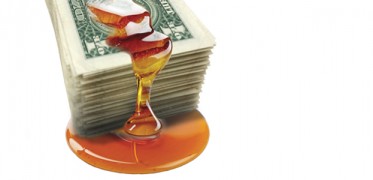How Sweet It Is!

The Maine maple syrup that enhances the flavor of pancakes and ice cream also adds to the statewide economy.
University of Maine economist Todd Gabe says, including multiplier effects, Maine’s maple industry annually contributes about $49 million in revenue, 805 full- and part-time jobs and $25 million in wages to the state’s economy.
Multiplier effects occur when an increase in one economic activity initiates a chain reaction of additional spending. In this case, the additional spending is by maple farms, businesses that are part of the maple industry and their employees.
“The maple producers were really helpful in providing me with information about their operations, which allowed for a really detailed analysis of their economic impact,” says Gabe, whose study was released in February.
Each year, the industry directly contributes about $27.7 million in revenue, 567 full- and part-time jobs, and $17.3 million in wages to Maine’s economy, Gabe says.
Maple producers earn about 75 percent of the revenue through sales of syrup and other maple products, including maple candy, maple taffy, maple whoopie pies and maple-coated nuts, he says.
Retail sales at food stores and the estimated spending of Maine Maple Sunday visitors on items such as gasoline and meals accounts for the remainder of revenue. This year, Maine Maple Sunday will be celebrated Sunday, March 23 at 88 sugar shacks and farms across the Pine Tree state.
Maine has the third-largest maple industry in the United States. According to the United States Department of Agriculture, maple syrup is produced in 10 states — Connecticut, Maine, Massachusetts, Michigan, New Hampshire, New York, Ohio, Pennsylvania, Vermont and Wisconsin.
In 2013, Maine accounted for 450,000 gallons, or 14 percent, of the 3,253,000 million gallons produced in the U.S. Vermont (1,320,000 gallons) and New York (574,000) were the top two producers. Among the three top-producing states, Maine had the highest growth rate (25 percent) of production between 2011 and 2013, Gabe reports.
In Maine, the maple production industry appears to be dominated by a few large operations; the 10 percent of maple farms with 10,000 or more taps account for 86 percent of the total number of taps in the state, he says.
While the maple producers that participated in Gabe’s study had an average of 4,109 taps, almost 40 percent of Maine’s maple producers had fewer than 250 taps. The study participants have been tapping trees and boiling sap for an average of 24 years.
Depending on temperature and water availability, the length of the sap flow season varies; in 2013 it ran from March 4 to April 12 in Maine.
Close to 40 percent of the maple producers that are licensed in Maine returned surveys for the study, which received financial support from the Maine Agricultural Development Grant Fund and the Maine Maple Producers Association.
Contact: Beth Staples, 207.581.3777
